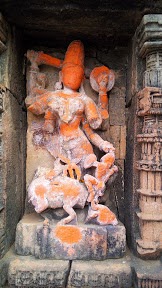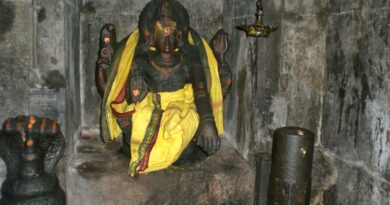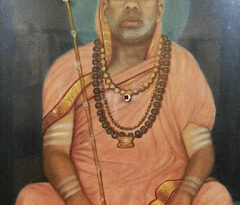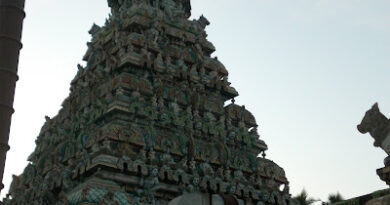Omkareshwar Jyothir Linga – Where Adi Sankara met his Guru
Omkareshwar is located in Madya Pradesh and is one of the 12 holy Jyothir Lingas of Lord Shiva. It is an island formed by the Narmada river which branches into two and then joins after crossing the omkareshwar hill. This island is called Mandhata or Shivapuri and seen from above takes the shape of the Hindu holy word “Om”. Hence, this place got the name Omkareshwar. The other branch of the river is incidentally called Kaveri.
Omkareshwar has been a very holy place since ages and due to its remote accessibility in the past, many saints and mystics used this place for their meditation and penance. The bridges to the town were all constructed very recently and a few hundred years ago one had to reach this place crossing the rapid currents of the Narmada by swimming or with a boat.Even today, it is dotted with Ashrams like Anandya Mayi Ma ashram,Gajanan Maharaj Ashram etc. and we can see seekers from all over the world coming here to spend some time in solitude.
Adi Sankara Cave
One prominent example of the historicity of the town, has been that of Sri Govindha Padacharya who was the Guru of the great Hindu saint Sri Adi Sankaracharya. Sri Govindhapada was staying in a cave in Omkareshwar close to the river. When Sri Sankara took up a monastic life and set out in search of a qualified Guru, he met Sri Govindhapada here travelling all the way from Kerala to Omkareshwar by foot. Once he met this Guru, he poured out a mystic hymn called “Athma Shadakam or Nirvana Shadakam” meaning “6 verses of the eternal soul”.The cave where this happened still can be seen below the Omkareshwar temple. Not much has changed inside the cave and it takes you back thousands of year. The cave had secret passages to the Narmada river but it has been closed now. But we can still see some portions of the passage.The second time Sri Sankara met his Guru was when the river Narmada was in floods and his Guru was in deep meditation unaware of himself. Sri Sankara then prayed to Narmada and the flood subsided. This incident is depicted in one of the sculptures in the cave.
The Jyothir Linga temple was also built by Sri Sankara and we can notice that the place surrounding the Shiva linga is always wet with the water from Narmada. There are hundreds of temples surrounding the main temple and across the river like Siddhanath Mandir, Somnath Mandir, Rinmukteshwar Mandir etc. There is a short Narmada parikrama path (Circumambulation) of 7 Kms which we can undertake to see the place in its entirety. These temples display the traditions of India’s past in Architecture, Sculpture, Paintings and in every field. The natural beauty of the entire place with the river, mountain, trees and the climate is an experience by itself!


It must be mentioned here that the Bana Linga which is worshipped in most of the Shiva temples comes from the Narmada river. Just the like the Salagrama stone from Nepal represents Lord Vishnu the Bana Linga stones from the Narmada river represent Lord Shiva. We can see a variety of Bana Lingas in Temples all over Omkareshwar and wherever the Narmada flows. There is a larger Narmada Parikrama undertaken by many Sadhus which is over 2700 Kms and takes several months.
Taking a holy dip in the Narmada here is considered auspicious on any day. There are several ghats like Koti Tirtha Ghat, Chakra Teertha Ghat near the temple where devotees can perform pujas and take a holy bath. The confluence of the two branches of the Narmada at Omkareshwar is also a perfect place for a snan.
Narmada Jayanthi or Narmada Janmotsav is similar to the chath Puja celebrated for the river Ganga. It usually occurs in the month of Magh. It is celebrated with great variety and splendour. Special pujas are offered to the Narmada river along with Maha Aarthi and in the evenings lamps are lit across all the bathing ghats of the river. It is also accompanied by fireworks and distribution of food to the poor.
Location: Omkareshwar, Madhya Pradesh, India



